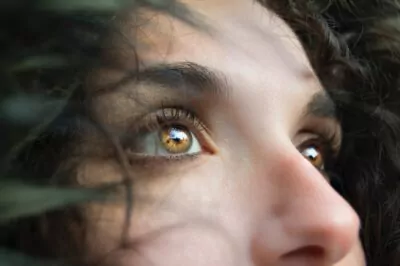Table of Contents[Hide][Show]
You take one look in the mirror and the only thing you can see are the dark circles under your eyes—you’re not alone. Periorbital melanosis (the technical term) is an extremely common disorder, so it’s no surprise that the beauty market is saturated with products promising to banish unsightly rings.
As if looking exhausted wasn’t enough, dark circles can sometimes be accompanied by burning and itchiness, too. The good news is that this universal affliction can be self-treated providing you aren’t experiencing eye discomfort, double vision, or a change in vision whatsoever; that’s when it’s time to call the doctor.
So, why do we get dark circles and what can be done about them? All the answers you need lie ahead.
Symptoms of eye fatigue
Research suggests that more than 60 percent of Americans have experienced symptoms associated with eye strain. This is no surprise considering 83 percent of Americans are on a digital device for two-plus hours a day—53 percent of whom use two devices at the same time. Symptoms of eye fatigue include:
- Headache
- Blurred or double vision
- Sore or irritated eyes
- Increased sensitivity to light
- Pain in the neck, shoulders, and back
- Eye twitching
- Difficulty focusing
- Dry or watery eyes
Causes of eye fatigue
While many people believe that tired eyes indicate a lack of sleep, there are actually several other causes that you may not be aware of. For example:
Activities that require intense eye use
This includes reading, writing, driving, looking at a bright light, spending time in a dark place, and staring for too long at computers (known as computer vision syndrome or digital eye strain.)
Allergies
Whether you suffer from seasonal allergies or have an aversion to dust or mold, the release of histamine dilates the blood vessels, thus leading to increased blood flow under the eyes.
This precipitates itchiness, swelling, inflammation and fluid accumulation under the eyes, all of which lead to dark circles and a tired appearance— particularly after rubbing or scratching your eyes. Nasal congestion is another contributor.
Dehydration
The body is comprised of 60 percent water and we’re constantly losing H2o through urination and sweating. Dehydration is not only dangerous for your health and zaps your energy, but it can also make you feel sleepy and lead to tired-looking eyes, even after eight hours of sleep.
Because dehydration decreases your blood volume, your heart starts to work less efficiently, which eventually leads to exhaustion. While there are several opinions about how much water one should drink on a daily basis, the easiest one to remember is the 8×8 rule—eight eight-ounce glasses.
Excessive under-eye pigment
Some people just have more pigment genetically (more melanin) which can lead to darker circles under the eyes. Certain ethnicities, such as those with darker skin tones, are more apt to acquire dark under-eye circles than other races.
Bone structure
If eye sockets are more sunken in, then the shadow of your bone structure makes dark circles more noticeable. However, some people simply have a genetic predisposition to forming dark circles under the eyes, which are often present as early as childhood.
Prominent blood vessels
When the blood in the veins under the skin beneath the eyes is oxygenated, it causes bluish-black circles.
Age
With age comes a loss of elasticity and a weakening of connective tissue that causes sagging skin. When this transformation takes place under the eye area, it creates bags, which impart a heavy, sleepy look.
Salty foods/water retention
Lay off the salt shaker as that white dust leads to water retention in the body, including your eyes. If the puffiness under your eyes is worse in the morning and better by later in the day, it’s likely that you were retaining water and are eating too much salt.
Tired eyes prevention
Obviously, you can’t prevent dark circles if they are linked to genetics, bone structure, or excessive pigment, but you can protect your peepers from getting shadows by taking a few precautionary measures. Note that these are lifestyle changes as regularity is the key to prevention.

Be mindful of your computer screen
It’s likely that you’re on your computer at least two hours a day, but if you have a job that requires one, that time period can easily climb up to eight hours-plus. We tend to hunch over and butt our faces up close to the screen, which in turn causes eye strain.
Make sure that your screen is 20-26 inches away from your eyes and a little below eye level—ideally, choose a screen that can tilt and swivel. Make an effort to regularly clean off dust and fingerprints from the surface as smudges can reduce contrast and create problems like glare and reflections. Up the ante by placing a glare filter on your screen.
Tweak your work environment
Change lighting to get rid of glare and harsh reflections. If you work in an office where this can’t be controlled, at least place an appropriate lamp on your desk to deflect some of the eye-straining light. An adjustable chair can help you control the level at which your eyes are focusing on your computer screen.
Practice healthy work habits
Make sure to take regular breaks to give your eyes a rest. Adopt the 20-20-20 rule. Every 20 minutes, look at an object about 20 feet away for 20 seconds. Take breaks from the computer all together by engaging in a non-digital task.
When your eyes are focused on your computer screen or while reading your blink rate decreases approximately 66 percent. Post a note that says “Blink” on your computer as a reminder.
Adopt an eye-care routine
Look at this like a ritual—perhaps something you do before bedtime. Apply a washcloth soaked in warm water to tired, dry eyes (keep your eyes closed.)
Make it a habit to keep artificial tears in your purse, desk drawer, or on your nightstand so you can refresh your eyes when they feel dry. Invest in a humidifier to add moisture to the air and always use an air cleaner to filter dust within your home.
Stop looking tired: tips to end puffy eye woes
Nobody’s perfect, so it’s likely that you’ll slip up from time-to-time. Here’s how to handle those pesky dark circles when they surface.
Stay hydrated
If you’re not into water, jazz it up by adding lemon to it. Taste aside, lemon is a natural diuretic that can help eliminate bloat that causes dark circles and puffiness. Get yourself a water bottle so you remember to drink it throughout the day.
Apply a compress
If you wake up with puffy eyes, make a compress by soaking cotton in rosewater; chill in the refrigerator or freezer before use. Roses are rich in phenolic compounds that serve as antioxidants.
These buds also have anti-inflammatory properties to help alleviate puffiness. Cucumber slices are another amazing natural remedy. Coolness aside, the vitamin C and caffeic acid in this green veg helps soothe skin and reduce the appearance of puffiness.
Invest in a quality eye cream
A good eye cream is a staple in any beauty regimen, but it can also be your saving grace when dark circles appear. Annmarie’s Anti-Aging Eye Cream helps peepers look rested, thanks to soothing herbs and active plant cells.
Antioxidant-rich green tea and goji berries reduce the appearance of fine lines and wrinkles, while cucumber extract and the herb eyebright temporarily ease puffiness.
Avoid artificial sweeteners
Studies indicate that artificial sweeteners can cause dark circles because they disrupt the body’s ability to absorb nutrients and accept enzymes. They are also potentially causing fluid retention, so cut back on diet soda drinks and putting those little pink and blue packets into your coffee to see if you notice a difference.
Wear sunglasses
Along with helping you to avoid squinting (which can lead to fine lines and wrinkles), shades protect your eyes from UV damage while shielding them from the glare of the sun, wind, dust, and other environmental conditions that can encourage puffiness.
Have your thyroid checked
If you’re noticing some other health issues along with your dark, puffy eyes, have your thyroid checked by a doctor.
A simple blood test will determine whether or not you don’t have hypothyroidism, a condition that occurs when the thyroid gland is underactive and doesn’t produce enough thyroid hormone.
Get enough iron
An iron deficiency can make dark circles more prominent because the hemoglobin in your blood breaks down more easily, which makes the thin skin below your eyes appear darker.
Make sure you’re eating enough iron-rich foods such as spinach, broccoli, beans, lentils, nuts, seeds, whole grains, red meat, chicken, duck, liver, pork, eggs, and fish. Talk to your doctor about whether or not a supplement is necessary.
Make an egg white eye remedy
Whip up an easy DIY egg white eye mask by whisking two egg whites and applying underneath the eye area. Along with having a tightening effect, egg whites are an astringent that helps banish dark circles and puffiness.
Avoid salty snacks
Prevent water retention by laying off the salt shaker and banishing salty snacks. The American Heart Association recommends no more than 2,300 milligrams (mg) a day—ideally, more than 1,500 mg per day for most adults.
In conclusion
Dark eye circles are caused by more than just a lack of sleep, though eye fatigue is a major factor considering the staggering amount of time Americans are spending on their digital devices. Take care of your eye health by taking breaks from the computer and setting up a healthy office environment, and regularly applying warm compresses and eye drops.
Make sure you’re drinking enough water and easing up your salt intake to avoid dehydration and fluid retention. Your skin care routine should include high quality eye care products for both preventative and on-the-spot care for your eyes.
If you feel you are making all of the correct strides to avoid dark circles but aren’t successful, consider making an appointment with your doctor to see if there’s something else going on like an iron deficiency or an underactive thyroid.
7 Things You Can Do to Reduce the Appearance of Wrinkles Naturally — No Products Required
Sources
“An Approach to Dark Circles Under the Eyes,” Researchgate, July 2016, https://www.researchgate.net/publication/305741162_An_approach_to_dark_circles_under_the_eyes
“Eye Strain: What Might Make Your Eyes Feel Tired,” American Academy of Ophthalmology, October 18, 2018,
https://www.aao.org/eye-health/diseases/what-is-eye-strain
“Digital Device Use and Eyes,” American Refractive Surgery Council, April 23, 2018
https://americanrefractivesurgerycouncil.org/digital-device-use-eyes/
“Computer Vision Syndrome,” University of Iowa Hospitals and Clinics,
https://uihc.org/health-topics/computer-vision-syndrome“Study: Artificial Sweetener May Disrupt Body’s Ability to Count Calories,” Purdue News, June 29, 2004 https://www.purdue.edu/uns/html4ever/2004/040629.Swithers.research.html
“Foods High in Iron,” Health Direct, https://www.healthdirect.gov.au/foods-high-in-iron
“How Much Sodium Should I Eat Per Day?,” American Heart Association,
https://www.heart.org/en/healthy-living/healthy-eating/eat-smart/sodium/how-much-sodium-should-i-eat-per-day








Ensuring proper eye health is important to achieve or maintain good vision. Eyes are one of the most crucial assets that enable us to see the world. Inculcating various lifestyle practices and positive changes, we can achieve good eyesight.